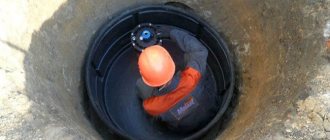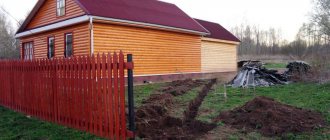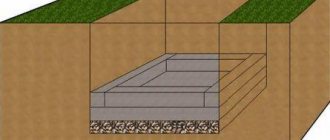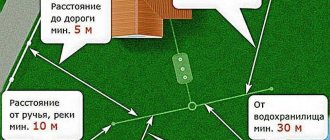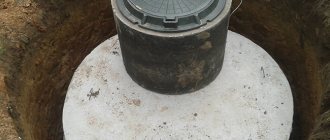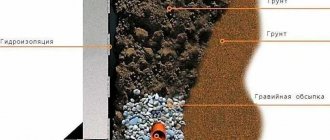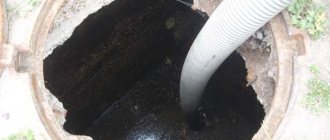Often the distance from the septic tank to the well according to SNiP (SP) and SanPiN standards is determined by the different distance at which a septic tank or cesspool can be made. This standard is determined by environmental considerations or the technical characteristics of the device. However, even the minimum distance between the septic tank and the well provides for the possibility of contamination of the source of drinking water if the sump is depressurized.
At the summer cottage
Permission
Before constructing a cesspool, you must obtain permission. For this purpose, the SES provides:
- Scheme of the location of the object on the site.
- The design of the structure, and it must comply with sanitary standards and regulations.
If documents are submitted that do not comply with the requirements of the law, permission will not be obtained.
But that’s not all, because after construction is completed and even several years later, an inspection inspector may come. In fact, the distance to the cesspool from the well and from other key points must correspond to the submitted documents. Inspectors do not conduct inspections at their own discretion; they often appear on a “tip” from neighbors.
Important! Do not neglect obtaining a permit; it will not cost much. You will have to stand in the corridors of the government agency, but it is cheaper than paying a fine if the distance from the well to the cesspool is incorrect.
It will be possible to obtain permission only if the cesspool is located not on the territory of a neighboring plot, but on your own. Moreover, it does not matter whether this (someone else’s) plot is residential or not and whether it is owned by someone.
Instead of results
With the advent of plastic septic tanks, the need to perform complex construction work - installation and concreting of rings - disappeared. The problem with metal corrosion, which was a common cause of breakthroughs in treatment facilities, has also been resolved. Now, if there is limestone under the soil layer, there is no need to drill it. It is enough to dig a hole of the required depth. But it is always necessary to understand in what segment a well can be drilled.
In the countryside
If you seek help from a specialist, you can reduce these standards. The rules have certain clauses that can be taken into account. For example, the distance to communications from water pipes can be reduced by using cast iron rather than plastic pipes.
Types of structures
The placement of a drainage pit in a private house differs in distance standards, depending on the type. The classification is based on the tightness of the structure. Types:
- A simple pit is a pit in the ground into which wastewater is discharged. There is no tightness in the design, so drains can spread in any direction. Here the distances should be maximum from all key points on the site.
- Pit with hard walls. They create less emissions into the soil, which means they are safer. The drainage does not seep through the walls; it goes only into the soil, through the filter bottom - a mixture of sand and crushed stone. Since the wastewater still leaves the cesspool, the distance from the house and from the well is also the maximum according to the standards.
- Sealed pits or plastic containers do not allow sewage to enter the soil at all. The cesspool is cleaned using the pumping method. It is allowed to maintain a minimum distance from the well.
Important! According to SanPiN, any cesspool must be installed only in accordance with the project and after approval by the relevant regulatory authorities.
What do you need to start from?
The exact distance from the septic tank is regulated by the Federal Service for Surveillance on Consumer Rights Protection and Human Welfare (Rospotrebnadzor). Refers to the federal executive authorities, specializing in control and supervision of the sphere of ensuring sanitary and epidemiological safety of the population of the Russian Federation.
At the stage of designing the location of the septic tank, it is necessary to adhere to a number of sanitary and epidemiological rules and regulations (SanPiN), as well as building codes and regulations (SNiP):
- SNiP 2.04.03-85 “Sewerage. External networks and structures" is the main document containing the essence of the topic raised.
- SNiP 2.04.01-85 “Internal water supply and sewerage of buildings” is a standard that includes standards for the distance of settling tanks from drinking water.
- SanPiN No. 2.1.5.980-00 “Hygienic requirements for the protection of surface waters” - a list of rules characterizing the boundary of the protection zone relative to the surface of reservoirs.
- SanPiN 2.2.1/2.1.1.1200-03 “Sanitary protection zones and sanitary classification of enterprises, structures, and other objects” - a document regulating the passage of sanitary zones around objects that pose a potential danger (which include septic tanks)
- SanPiN 42-128-4690-8 “Sanitary rules for the maintenance of territories of populated areas”, regulating the rules for arranging a septic tank.
These regulations list all current distances to objects located on the land plot and beyond. The conditions for their installation, operation and maintenance are described in detail.
SNiP standards
According to SNiP, a cesspool is an object of increased environmental hazard, therefore its placement must comply with certain standards, namely:
- The distance between the well and the cesspool is 20-50 meters. The same standards apply to the distance from any source of drinking water - a well, a standpipe, or another type of water intake.
- From the foundation of your own house, the neighbor’s, the foundations of other buildings, at least 10-12 meters. If you place the cesspool closer, in the event of a violation of the integrity of the wastewater storage facility, there is a risk of erosion of the foundation and, as a result, destruction of the building.
- The distance from the cesspool to the water supply and its pipes. At least 10 meters; such a distance will prevent sewage from entering the water supply in the event of an accident on the sewer pipeline.
- The depth of the pit should not be more than 3 meters, and only in case of deep groundwater. If they are located high, then only sealed containers or septic tanks can be installed. In both the first and second cases, it is necessary to maintain a distance of 1 meter from the bottom of the pit to the groundwater level. The release of wastewater into the soil is dangerous because it pollutes groundwater, and therefore sources of water intake.
- There should be at least 1.5 meters to the property line (fence), but it is better to do more, then you will be able to avoid troubles with neighbors.
- To the highway, road, if there is one near the site - from 5 meters.
- Distance from a stream, river – from 10 m.
- If there are trees and shrubs on the site, then you need to place cesspools and septic tanks at a distance of 3 meters or more. The decision to move the cesspool into the garden is not the best, because the roots of the plant can simply rot from excess moisture, and besides, not all of them are so moisture-loving.
- It is also impossible to place a cesspool closer to the garden; placement standards are 20-30 meters.
Important! The arrangement of an outdoor toilet also requires compliance with similar standards if a sealed container is not used as a cesspool. A toilet in a country house, although it is not used as often as a sewer system in a private house, it must be placed in accordance with the above standards.
Consequences of incorrect placement
In drilling, the main thing is that the source shaft is located above the aquifer. It is necessary to choose a convenient location that provides access for the drilling machine.
Finding the aquifer is sometimes difficult. For better results, you should pay attention to some side factors:
- geological feature of the site;
- close proximity to surface water;
- typical plant species.
Sometimes it is worth doing exploratory drilling.
There are a number of other factors that must be taken into account when drilling. This is primarily protection from contamination. Incorrect location of the source can lead to runoff, industrial waste and landfills.
The minimum location from the septic tank is at least 30 m, and preferably 50 m. The distance from garbage heaps or industrial warehouses is 100 m or more.
If there are communications on the site
When the location of the site is such that underground communications pass through it, then a certain distance must also be maintained to them. The distance of the cesspool depends on the type of pipes:
- Asbestos-cement or reinforced concrete - from 5 meters.
- Cast iron with a diameter of up to 20 cm - 1.5 m.
- Cast iron with a diameter of more than 20 cm - from 3 m.
- Gas pipes – from 5 meters.
Important! When moving pipes away from the cesspool on a site, you should be guided by the rule, the farther the better.
Requirements for small cesspools
If the productivity of the pit is from 1 to 8 cubic meters per day, then the sanitary requirements are more lenient. The distance to the house can be from 5 to 8 meters. The pit can be located at the same distance from the water intake structure.
If the pit's productivity is not higher than three cubic meters per day, water supply to the house from the source is allowed to be made downstream of the water in the aquifer underground. The distance between structures should be over forty to fifty meters. If a pit with the same volume of waste is located higher than the water flows in the horizon, then the gap can be reduced to 25 meters. If the liquid in the horizon moves perpendicular to the location of the pit, then the distance should be from 25 to 30 meters. Artesian springs and wells can be removed from the pit by 20 meters.
Attention! When building a pit of a sealed structure, it is necessary to take into account the optimal distance when it is located below the direction of water flow in the horizon, or above.
Punishment for non-compliance
They are punished for violating the rules for the location of cesspools and street toilets with a ruble, that is, they issue a fine. Its size depends on several factors:
- Have any cases of violation of environmental legislation by a citizen been previously recorded?
- How badly the norms have been violated. This means that if the cesspool is closer than necessary to the foundation of the house, the fine will be less than if a potentially dangerous object is located closer than 20 meters from a source of drinking water.
The specific amount of punishment is determined by the court; it is in court that the measure of punishment for such an offense is determined. Violation of environmental standards is dangerous for many people, so fines amount to thousands of rubles.
Features of gas connections
When connecting gas stoves, water heaters and other types of equipment, flexible hoses are also used. Unlike water models, they are yellow and are not tested for environmental safety. For fixation, end steel or aluminum reinforcement is used. There are the following types of devices for connecting gas appliances:
- PVC hoses reinforced with polyester thread;
- made of synthetic rubber with stainless steel braid;
- bellows, made in the form of a corrugated stainless steel tube.
The Santekhkomplekt holding offers engineering equipment, fittings, plumbing fixtures and devices for connecting them to communications. The assortment is represented by products and materials from well-known foreign and domestic manufacturers. Discounts apply for bulk purchases, and product quality is confirmed by standard certificates. For information support and assistance, each client is assigned a personal manager. The ability to arrange delivery within Moscow and to other regions of the Russian Federation allows you to quickly receive the purchased goods without unnecessary hassle.
If there is not enough space
It happens that those responsible for violating sanitary standards make excuses by saying that there is not enough space, and that is why they violated the rules. But in fact, it is possible to install a toilet correctly or arrange a cesspool. If, according to the standards, there is not enough space on the site, the solution is to construct a pit using a sealed container. There are also septic tanks and other installations that can be mounted on the surface, they are also sealed.
Of course, such solutions are more expensive than a cesspool, but by not complying with SNiP standards, the owner of the site primarily harms himself. It pollutes water and makes the soil unsuitable for growing any vegetables, trees, and shrubs.
Compliance with sanitary standards regarding the placement of a cesspool and the location of the toilet according to SNiP in the country is very important. Violation is fraught not only with fines, but also with harm to one’s own health.

